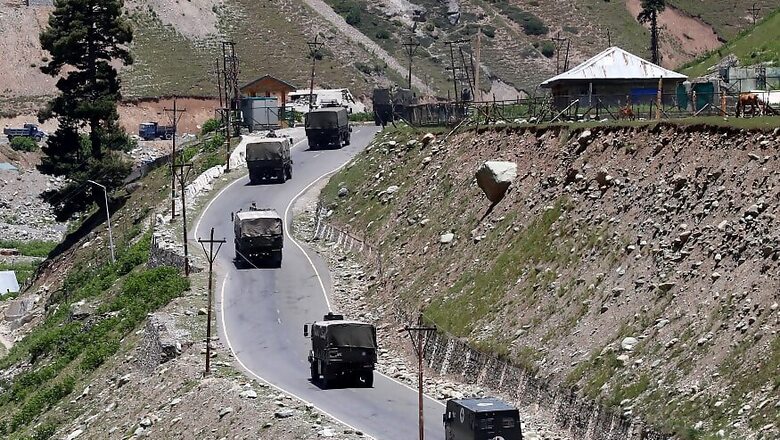
views
The People’s Liberation Army (PLA) has returned several Indian soldiers taken prisoner during Monday’s savage hand-to-hand fighting in the Galwan river, as part of an unfolding effort to reduce tensions between military units which remain locked in an eyeball-to-eyeball confrontation along the Line of Actual Control (LAC) in Ladakh, highly-placed government sources have confirmed to News18.
Lieutenant-Colonel Maninder Nagpal, second-in-command of the 16 Bihar Regiment, credited by survivors with organising resistance to the PLA attack after the killing of 16 Bihar Commanding Officer K Santosh Babu, was among four officer-rank prisoners returned.
Government sources said the prisoner release was organised during discussions between Karu-based 3 Infantry Division, Major-General Abhjit Bapat, and his PLA military counterpart on Thursday.
Following the prisoner release, China’s foreign ministry spokesperson Zhao Lijian said the country “has not presently seized any Indian prisoners” — language that was designed, an Indian diplomat said, to respect an agreement between both governments not to discuss the issue in public.
The officers returned on Thursday include Captain Arjun Deshpande, among those that survivors have said played a key role in Lieutenant-Colonel Nagpal’s efforts to defend Point 14.
Leh-based military sources said other soldiers returned by the PLA included Subedar Ashutosh Kumar, Naib-Subedar Surjit Singh, Brigade Havaldar-Major Bhuri Singh, Havaldar Ashutosh Kumar, Lance-Naik Dola Singh and Sepoys Ram Vijay, Baljit Singh, Ghoshan Singh, Kuldeep Singh and Avtar Singh.
Leh-based sources said five of the soldiers had sustained significant injuries in the course of the fighting and four had fractures.
Officials say examination of the slain soldiers show most suffered trauma injuries, likely from being hit with iron rods or wood batons wrapped in barbed wire. In other cases, soldiers appeared to have been killed or injured after falling off the narrow trail leading to Point 14.
Little progress has been made in military-to-military talks towards deescalating tensions at Point 14, say government sources, with the PLA insisting the area lies on its side of the LAC. Maps published by the Chinese government after the 1962 war had asserted that claim, but the PLA had subsequently withdrawn to positions along a road more than 10 kilometres to the rear, leaving Indian troops free to patrol the valley.
“New Delhi is going to have to determine whether the attack on Point 14 was part of a plan authorised by the PLA’s command to intimidate India, or a local confrontation which spun out of control,” said Manoj Joshi, a New Delhi-based strategic affairs effort.
“The jury is out on that question — but the answer will likely determine whether disengagement efforts are successful or not,” he added.
Fighting had broken out at Point 14 after China pitched a tent near the location on Friday, days after a June 6 meeting where the commander of the Leh-based XIV corps, and Major-General Liu Lin, commander of the PLA in the South Xinjiang region, agreed to disengage troops there and at two other key locations, Point 15 and Point 17, where both armies had parked armoured vehicles.
Point 14 is sited on the north bank of the Galwan, several dozen metres above the river floor — a precaution against sudden floods which rage through mountain rivers. The nearest road-head on the Indian side of LAC is some seven kilometres away, and China’s some 11 kilometres distant.
Army sources say Colonel Babu’s patrol was dispatched to Point 14 when the PLA pitched a tent there just two days after the June 6 disengagement agreement. The patrol was attacked with stones and escalated into a melee in which the PLA’s tent caught fire.
Government sources said that in Thursday’s meeting with Major-General Bapat, the PLA complained India had ignored protocol — involving raising a white flag and unfurling banners asking the rival troops to turn back — when seeking to evict the Chinese tent at Point 14.
But no explanation, the sources said, was offered for why the PLA resiled on its commitment to remove its troops from Point 14. There was also no explanation or apology offered for the savage attack on Indian troops on Monday, which involved several hundred PLA soldiers.
Government sources say large numbers of Indian and Chinese troops remain dug in across the LAC in spite of diplomatic efforts to end the showdown. The largest concentrations are located between Finger 4 and Finger 5, the two contested ridgelines near Pangong Lake where this summer’s crisis was first sparked off. Forces also continue to remain face-to-face in the Hot Springs area.
“Lots of progress had been made at the diplomatic and political level to cool things down,” a senior Indian diplomat involved in the negotiations said, “but the tragic events on Monday have obviously narrowed the room for give-and-take.”
“The real danger now is that troops, who are understandably stressed after the killings in Galwan, will be quick to reach for their guns in the event of any future confrontation,” a military officer serving in the region said. “Events could spiral out of control very quickly.”















Comments
0 comment